Farmer John Writes: The Middle of Somewhere
Extended Season Week 2, November 28th – December 3rd, 2022
Welcome to the Last Delivery Week of the 2022 Season
A reminder to our extended season shareholders: since we condensed our extended season from the usual four weeks to two weeks, this week is the final delivery week of the 2022 season.
Make Sure that You Take the Right Number of Boxes this Week
Another reminder: if you are signed up for a full extended season share, you will receive two vegetable boxes this week. If you are signed up for a half extended season share, you will receive one vegetable box this week.
Brussels Sprouts Shortage
Upon sorting though our inventory of harvested Brussels sprouts, we had to discard many for being minuscule, spongy, or spoiled. If you ordered Brussels sprouts and do not receive them, our apologies. We will make sure to substitute with another item of similar value, probably a delicious carnival squash.
Your Empty Boxes
If you receive home delivery, please remember to leave your empty boxes where our driver can retrieve them. Regarding the last box(es) of the season that our driver will deliver to you this week, keep them until next season if you have signed up for next season, or re-cycle them. We cannot return to each home delivery address to retrieve boxes after the delivery season is over.
If you pick up your share at a community pickup site and you have our vegetable boxes at home, please flatten them and return them to your pickup site for our driver to return to the farm.
Thank You from Our Crew to Our Shareholders
I want to elaborate a bit on the spirit of thankfulness in last week’s Farm News, Thank You to All.
Your support of Angelic Organics has made life easier for our H-2A workers from Mexico. I asked one of our workers how much money he had saved out of his earnings here.
“Pretty much all of it,” he said, “My wife works, so she took care of the bills while I was gone.”
“What are you going to do with it?” I asked. (Yes, I am often direct with people, especially when they are friends, like this person is.)
“Build a house.”
“What’s that going to cost?”
“About $10,000 U.S. My father-in-law will provide the land.”
“What kind of a house?”
“Small—2 bedrooms, kitchen, living room, bathroom.”
“Fabulous,” I said.
Shareholders, you have helped to get this farm worker and his family into their own house. Blessings on you.
Thank You to Our Many Pack Volunteers
For each of the two weeks of the extended season, we are actually packing a few more boxes than we packed in one week during the regular season. That’s fine with us, as it’s getting the season finished earlier and mostly before our H-2A workers return home to Mexico.
Even as the days have turned colder, we still have many volunteers showing up to help pack boxes. It’s very uplifting to have their conscientious help throughout the season. Many of them have been volunteering for years here to help with the pack.
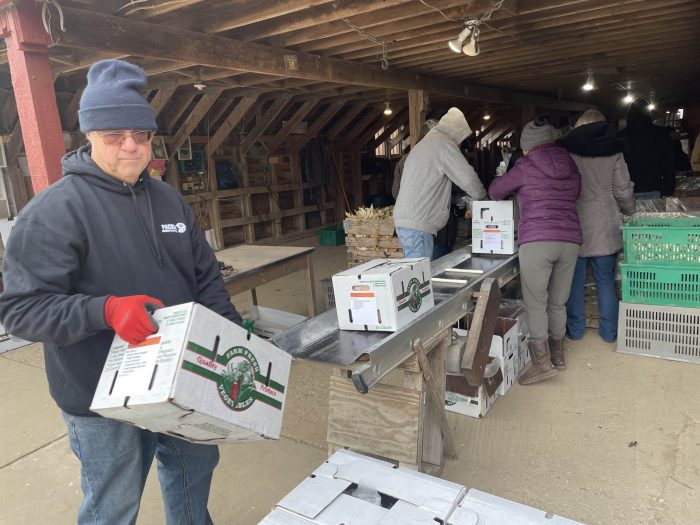
our faithful pack volunteers brave the cold
Heading up the pack volunteer program is the heroic and affable Don Glasenapp, who cheerfully and enthusiastically rallies and coordinates the volunteers, besides often making us laugh with his amusing insights and observations.
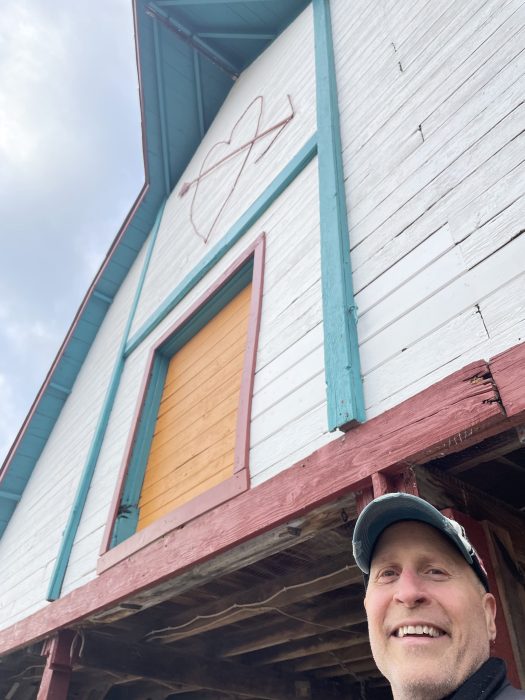
our affable pack volunteer coordinator Don Glasenapp
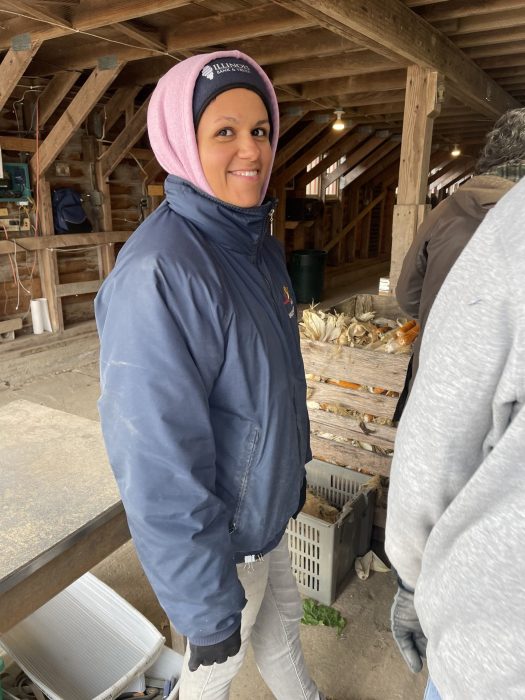
Farm employee Amanda audits box contents

Farm employee Nathan supplies the pack line
Thanks to the Crew
We had a stellar crew of H-2A workers from Mexico this season, bolstered by Eduardo (also known as Pollo—here for 22 years), Victor (here for 12 years) and Bartolo (here for 7 years.)
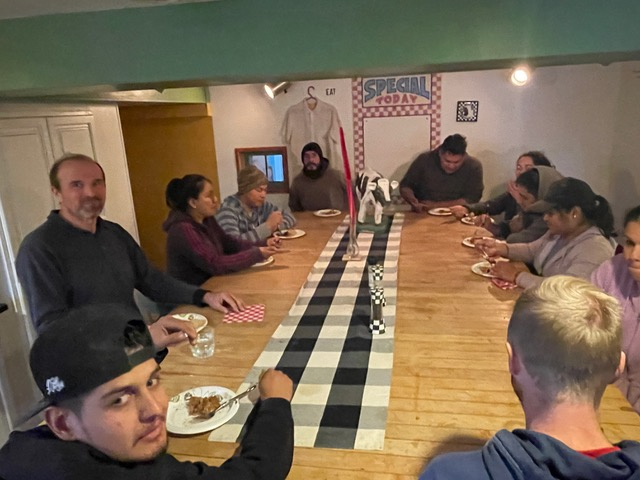
the crew enjoys Thanksgiving cherry and apple pie in the barn kitchen provided by my sister, Carol Krupke
My sister, Carol Krupke, provided a traditional Thanksgiving meal for the crew. This was a first for most of them.
In addition, I sponsored a Mexican end-of-season feast for them last week, prepared by exemplary 2nd year H-2A workers Concepcion and Maythe. They served flautas with salsas, tortillas de papas (potatoes), spaghetti with sour cream and cheese, horchata (rice drink), and Mexican hot chocolate. Cheesecake was prepared by convivial, bilingual Ilse.
After the superb and hearty meal, I showed the crew several videos of them working in the fields throughout the season.
Then I screened the feature documentary The Real Dirt on Farmer John, which most of them had not seen. It is subtitled in Spanish.
Film Discussion
After the film screening, we had a discussion. The discussion went in several directions, but what stands out in my memory is the question, “why did you make it?” (I’ll add here that I didn’t personally make the film; it was a collaborative effort.)
I replied, “To encourage people to keep going.”
“Here was a farm, dead, ruined, destroyed.
Hardly ever does a lost farm come back to life today. I had a redemption story to share, a resurrection story. Why did the farm come back to life? Because I kept going. You never know what’s around the corner–what’s next—and you will never find out, unless you keep going.”
I continued, “I think the best example of what I am talking about is the immigrant housekeeper from Bangladesh who cleaned my hotel room in Sweden. I gave her tickets to the film for her and her two daughters. (The film was screening at a film festival in Stockholm.) The next day, she came to clean my room again. She said, ‘I think you have no idea of how hard my life is, how hard it has been to go on in life. The film gave me hope that maybe life can get better. Thank you.’”
I never wanted to make a film about my life, never really wanted to be in a movie, to see myself on the big screen. I knew it would be a crazy amount of work to be in the film, with the filming going on and distracting me for years while I was running the farm, but I figured it was a story worth telling in this age of despair.
Tears
Watching the film again and having a discussion afterwards prompted me to reflect to myself more broadly on the film.
A person approached me shortly after the film came out—that was in the winter of 2005—and said, “I was one of the twelve jurors on the Sundance selection committee for documentaries, and I fought so hard for your film. It was supposed to be in Sundance. I failed. I’m not supposed to tell you this: your film lost by one vote.” She threw herself into my arms and cried. I cried along with her.
Through our tears, I said, “now I will have to work so much harder to get it out to the world.”
“I know,” she wailed.
The film was nevertheless seen by millions of people in many countries throughout the world and garnered 31 festival awards. Many thousands of people saw the film at the several hundred screenings that I personally presented. Many laughed. Many wept, some from sadness, some from joy, some from both. The audience members sometimes swaddled me in long, long hugs after the screenings. Some shuddered and even convulsed in my arms.
For example, after one screening, four tall handsome men maybe in their early forties approached and stood in front of me. One of them was sobbing, shaking. His friends looked at him, then at me, then at him. We were all just standing there with the one guy being in a breakdown. One of them finally said, “we’ve never seen him cry before. We’ve known him over twenty years and he has never cried.”
The crying man finally said, in an almost incoherent way, “I grew up in the Midwest. I hated it. It hated me, because I am gay. I could not wait to leave. Ever since, I have lived in San Francisco hating the Midwest. Until tonight. Tonight I saw the beauty of the Midwest, of the rural people, of the land. I saw the warmth, the hospitality, the heroism, and the love.” On the word love, he wailed and shook harder. It was catharsis. I am not sensationalizing. The film did something deep and real for many people.
Did I like touring with the film non-stop for five years, a film rated B-grade because it did not get into Sundance, and therefore was likely not fated to get into the other five major film festivals—Cannes, Toronto, Los Angeles, South by Southwest, and Tribeca? I didn’t love it, because the film didn’t have the wind at its back that the Sundance acceptance would have provided it. But, I was privileged to be able to share my story of redemption with millions of people anyway, and to inspire many of them with hope and determination. For this I am most thankful. (A bonus of traveling with the film for five rather grueling years—I met my fabulous. most lovely wife-to-be Haidy in Sweden at the last screening of the tour. Remember from above: You never know what’s around the corner.)
When I later reflected to myself on the question of why we made the film, I reminded myself of a couple of other reasons why I am thankful it was made:
1) I had been massively disparaged in my home community for many years, a sort of vindictive, self-perpetuating firestorm of hysteria that swept through this area (and beyond), instigated by a delusional neighbor. I wanted to tell my version of the story, the true version. A community should not create a lie and live by it; the lie will weaken the community.
2) I wanted people to see a farm as a living organism, a being, where nature and humanity converge to create food and fellowship and more life. I was weary of people referring to the drive between cities as being the middle of nowhere. Farms, I promise you, are in the middle of somewhere.
Your farm, Angelic Organics, is in the Middle of Somewhere. Thank you for helping it to be.
Warmly,
Farmer John

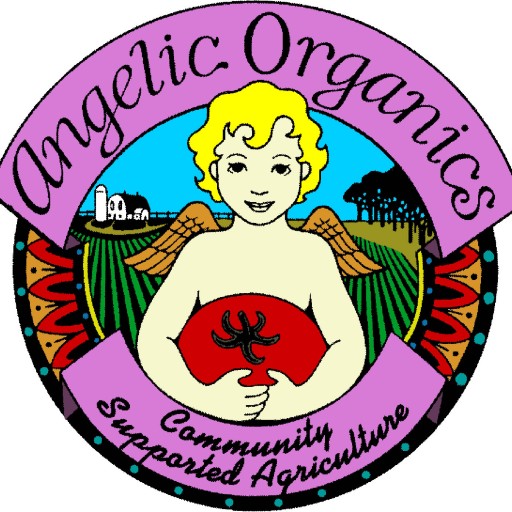


Thank you for sharing this. Deep. . .